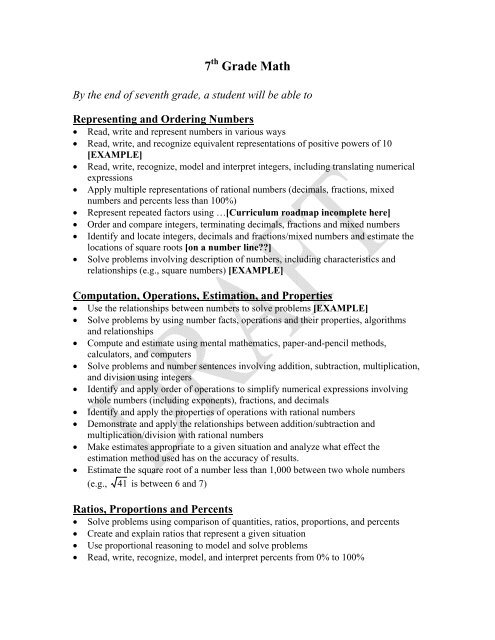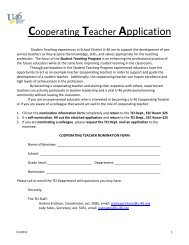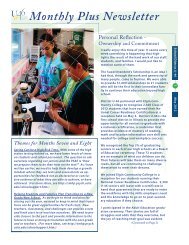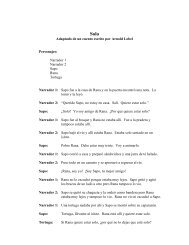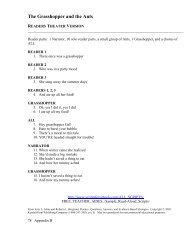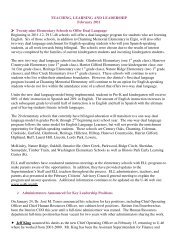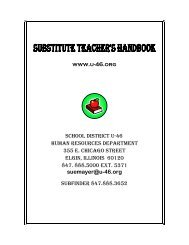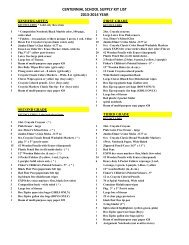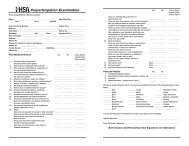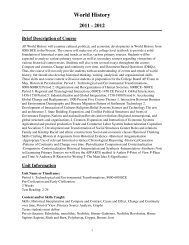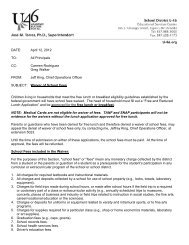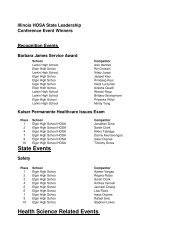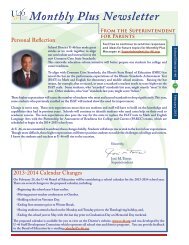7th Grade Math
7th Grade Math
7th Grade Math
You also want an ePaper? Increase the reach of your titles
YUMPU automatically turns print PDFs into web optimized ePapers that Google loves.
7 th <strong>Grade</strong> <strong>Math</strong><br />
By the end of seventh grade, a student will be able to<br />
Representing and Ordering Numbers<br />
• Read, write and represent numbers in various ways<br />
• Read, write, and recognize equivalent representations of positive powers of 10<br />
[EXAMPLE]<br />
• Read, write, recognize, model and interpret integers, including translating numerical<br />
expressions<br />
• Apply multiple representations of rational numbers (decimals, fractions, mixed<br />
numbers and percents less than 100%)<br />
• Represent repeated factors using …[Curriculum roadmap incomplete here]<br />
• Order and compare integers, terminating decimals, fractions and mixed numbers<br />
• Identify and locate integers, decimals and fractions/mixed numbers and estimate the<br />
locations of square roots [on a number line??]<br />
• Solve problems involving description of numbers, including characteristics and<br />
relationships (e.g., square numbers) [EXAMPLE]<br />
Computation, Operations, Estimation, and Properties<br />
• Use the relationships between numbers to solve problems [EXAMPLE]<br />
• Solve problems by using number facts, operations and their properties, algorithms<br />
and relationships<br />
• Compute and estimate using mental mathematics, paper-and-pencil methods,<br />
calculators, and computers<br />
• Solve problems and number sentences involving addition, subtraction, multiplication,<br />
and division using integers<br />
• Identify and apply order of operations to simplify numerical expressions involving<br />
whole numbers (including exponents), fractions, and decimals<br />
• Identify and apply the properties of operations with rational numbers<br />
• Demonstrate and apply the relationships between addition/subtraction and<br />
multiplication/division with rational numbers<br />
• Make estimates appropriate to a given situation and analyze what effect the<br />
estimation method used has on the accuracy of results.<br />
• Estimate the square root of a number less than 1,000 between two whole numbers<br />
(e.g., 41 is between 6 and 7)<br />
Ratios, Proportions and Percents<br />
• Solve problems using comparison of quantities, ratios, proportions, and percents<br />
• Create and explain ratios that represent a given situation<br />
• Use proportional reasoning to model and solve problems<br />
• Read, write, recognize, model, and interpret percents from 0% to 100%
• Solve number sentences and problems involving fractions, decimals, and percents<br />
(e.g., 50% of 10 is the same as of 10; calculate sales tax, tips, interest, discounts)<br />
Units, Tools, Estimation, and Applications<br />
• Use correct units of measure, estimate measurements and use the correct formulas<br />
and instruments to solve problems.<br />
• Select and use correct technology [EXAMPLE], interpret results, and communicate<br />
• Select and use appropriate standard units and tools to measure length, mass/weight<br />
capacity and angles. Sketch, with given instructions, line segments, angles, triangles,<br />
and quadrilaterals.<br />
• Solve problems with the perimeter and area of polygons and composite figures using<br />
diagrams, models, and grids or by using given formulas (may include sketching from<br />
its description)<br />
• Compare and estimate length (including perimeter), area, volume, weight/mass and<br />
angles (0º to 180 º) using referents.<br />
• Find the volume and surface area of a right rectangular prism using appropriate<br />
formula or strategy.<br />
• Solve problems involving unit conversions within the same measurements system for<br />
length, weight/mass, capacity, and square units (e.g., 1 ft 2 = 144 in 2)<br />
• Solve problems involving scale drawings and maps<br />
Representations, Patterns, and Expressions<br />
• Recognize patters, write and simplify expressions, and evaluate algebraic expressions.<br />
• Describe numerical relationships using variables and patterns [EXAMPLE]<br />
• Determine a missing term in a sequence, extend a sentence [sequence??], and<br />
construct and identify a rule that can generate the terms of an arithmetic or geometric<br />
sequence. [EXAMPLE]<br />
• Write an expression using variables to represent unknown quantities<br />
• Simplify algebraic expressions by identifying and combining like terms<br />
[EXAMPLE]<br />
• Recognize equivalent forms of algebraic expressions [EXAMPLE]<br />
• Evaluate or simplify algebraic expressions with one or more integer variable values<br />
(e.g., what is a 2 + b if a = 3 and b = -4)<br />
Connections using Tables, Graphs, and Symbols<br />
• Interpret and describe numerical relationships using tables, graphs, and symbols<br />
• Determine how a change in one variable relates to a change in a second variable<br />
[EXAMPLE]<br />
• Represent linear equations and quantitative relationships [using??] a coordinate<br />
system and interpret the meaning of a specific part of a graph [the Curriculum<br />
Roadmap appears to be missing one or more words]<br />
• Translate between different representations (tables, written, graphical, or pictorial) of<br />
whole number relationships and linear expressions<br />
• Identify, graph, and interpret inequalities on a number line
Equations and Inequalities<br />
• Interpret and solve problems by writing and solving equations and inequalities<br />
• Solve problems using systems of numbers and their properties<br />
• Use algebraic concepts and procedures to represent and solve problems<br />
• Represent and analyze problems with linear equations and inequalities [EXAMPLE]<br />
• solve linear equations (e.g,, 2x + 5 = 13) and inequalities involving < or ><br />
(e.g., 2x < 6, x +7 > 10)<br />
• Solve word problems involving unknown quantities<br />
Geometric Figures and Coordinate Geometry<br />
• Interpret and solve problems using the properties of geometric figures and coordinate<br />
geometry.<br />
• Demonstrate and apply geometric concepts involving points, lines, and planes<br />
• Classify, describe and sketch regular and irregular two-dimensional shapes according<br />
to the number of sides, length of sides, number of vertices and interior angles.<br />
• Solve problems involving two- and three-dimensional shapes<br />
• solve problems using properties of triangle and quadrilateral (e.g.,opposite sides of a<br />
parallelogram are congruent)<br />
• Identify, describe, and determine the radius and diameter of a circle<br />
• Graph points and identify coordinates of points on the Cartesian coordinate plane (all<br />
four quadrants)<br />
• Represent and identify geometric figures using coordinate geometry<br />
• Analyze the results of a combination of transformations<br />
• Identify or analyze relationships of angles formed by intersecting lines<br />
• Identify and sketch acute, obtuse, and right angles.<br />
• Solve problems involving complimentary and supplementary angles<br />
• Identify the relationships among multiple geometric figures and solve problems<br />
involving congruent and similar figures<br />
• Identify, describe, classify, and compare relationships using points, lines, planes, and<br />
solids<br />
• Identify a three-dimensional object from its net [EXAMPLE]<br />
• Recognize which attributes (such as shape, perimeter, and area) change or do not<br />
change when plane figures are composed, decomposed, or rearranged<br />
• Describe the difference between congruence and similarity<br />
• Determine if figures are similar and identify relationships between correspoinnding<br />
parts of similar figures<br />
• Determine the distance between two points on a horizontal or vertical number line<br />
• Construct convincing arguments and proofs to solve problems and provide logical<br />
justifications<br />
Data Analysis and Statistics<br />
• Read, interpret, and create displays of data and describe and analyze data<br />
• Organize, describe and make predictions from existing data
• Formulate questions, design data collection methods, gather and analyze date and<br />
communicate findings<br />
• Read, interpret, and make predictions from data represented in a line (dot) plot, Venn<br />
diagram (with two circles), chart/table, line graph, scatter plot, circle graph, or<br />
histogram<br />
• Compare different representations of the same data<br />
• Create a bar graph, chart/table, line graph, or circle graph for a given set of data<br />
• Identify a reasonable approximation of the line of best fit from a set of data or scatter<br />
plot<br />
• Determine and use the mode, range, median, and mean to interpret data<br />
Probability<br />
• Use the properties of probability<br />
• Determine, describe, and apply the probabilities of events<br />
• Solve problems involving the probability of a simple compound event, including<br />
representing the probability as a fraction, decimal, or percent [EXAMPLE]<br />
• Represent all possible outcomes for simple events<br />
• Solve simple problems involving the number of ways objects can be arranged<br />
[EXAMPLE]


